Comprehensive Report: Personal and Professional Development Plan
VerifiedAdded on 2020/01/28
|11
|2734
|29
Report
AI Summary
This report provides a comprehensive overview of personal and professional development. It begins with an introduction to self-managed learning, exploring different approaches, learning styles, and lifelong learning strategies. The report then delves into skills assessment, identifying current competencies and development needs based on professional standards. A detailed personal development plan is presented, outlining activities to improve skills such as leadership, communication, and time management. The report evaluates the effectiveness of the plan and provides an updated version. Furthermore, the report addresses a work-based problem and discusses effective communication styles at various organizational levels, along with time management strategies. References supporting the findings are also included.
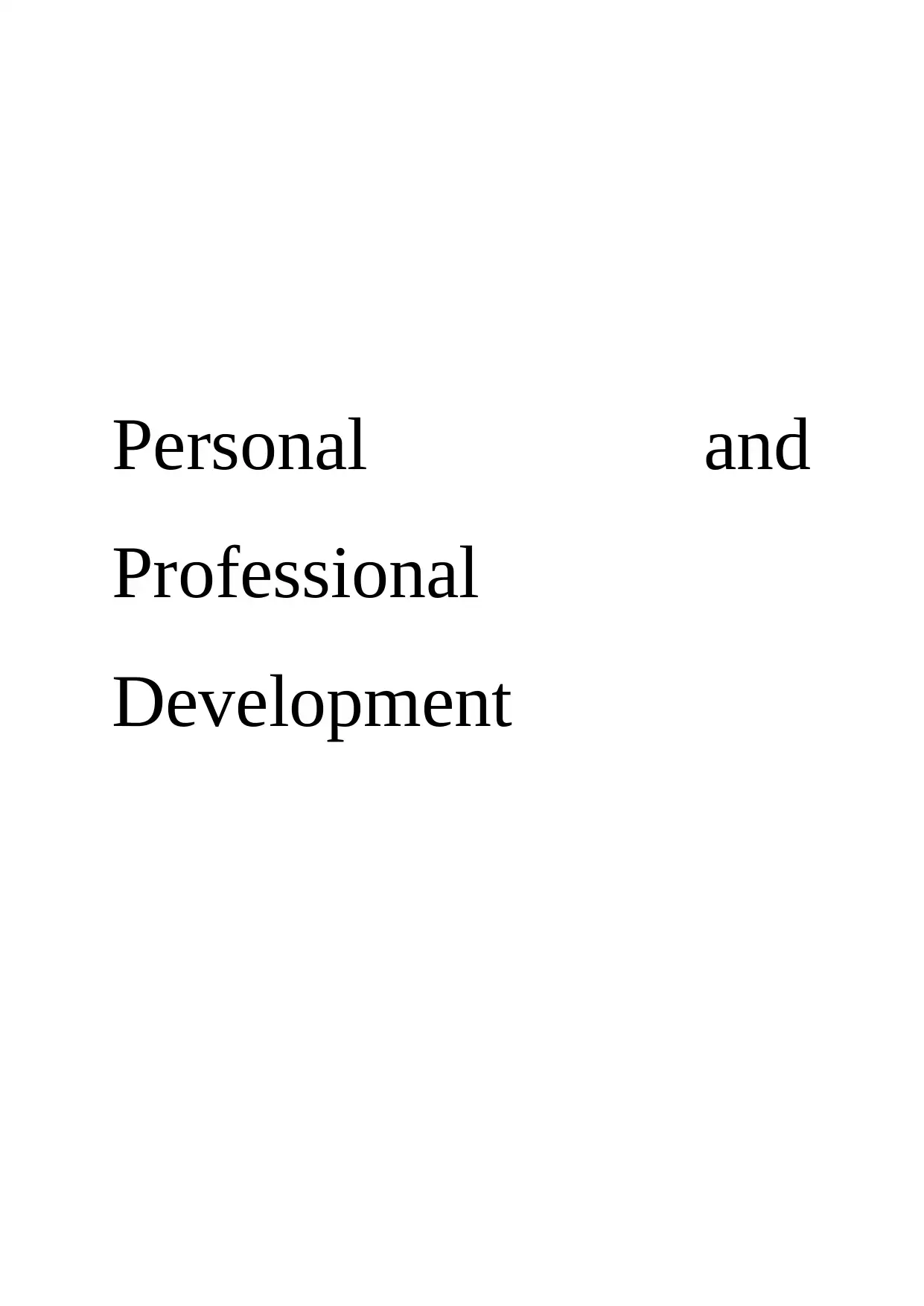
Personal and
Professional
Development
Professional
Development
Paraphrase This Document
Need a fresh take? Get an instant paraphrase of this document with our AI Paraphraser
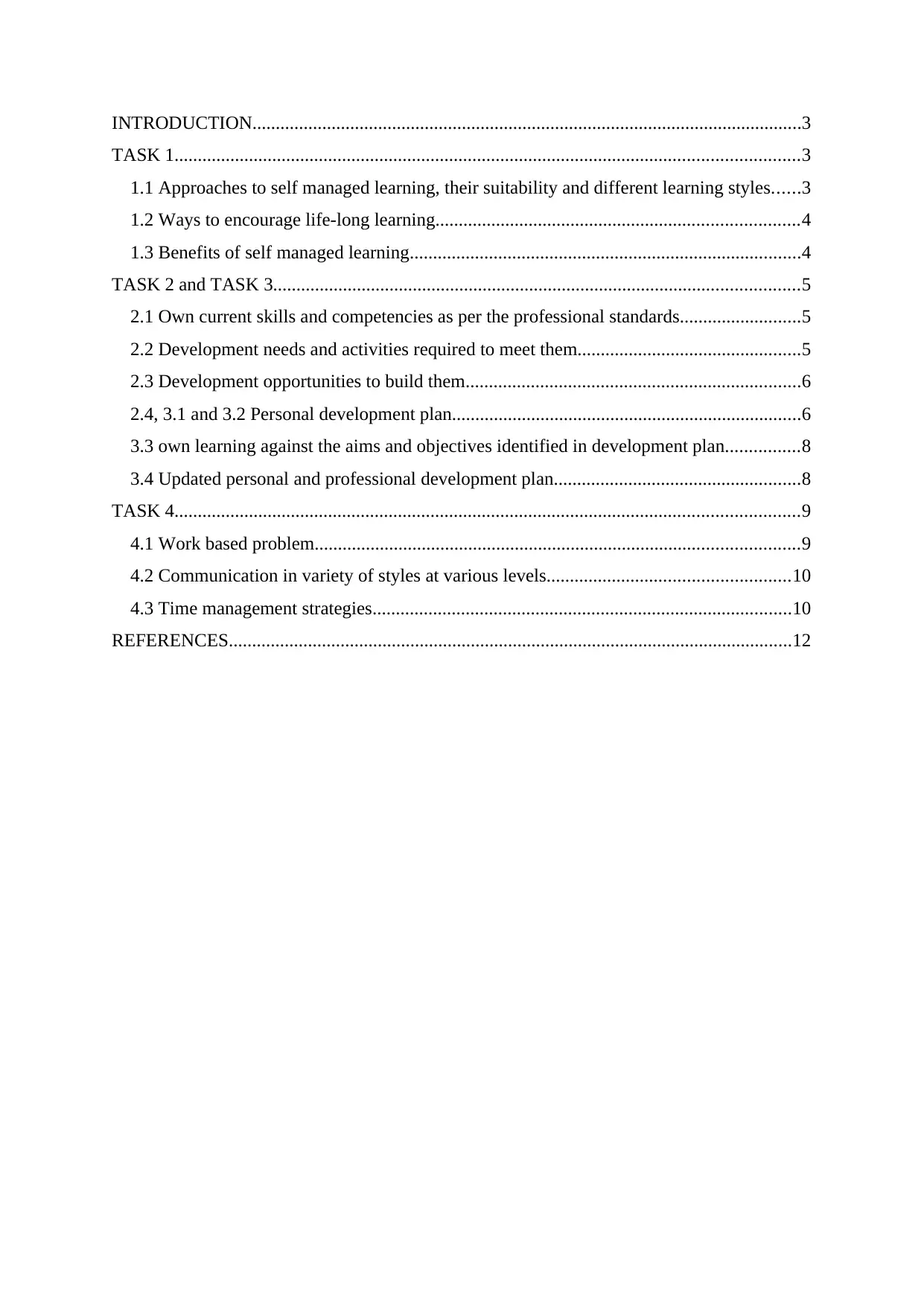
INTRODUCTION......................................................................................................................3
TASK 1......................................................................................................................................3
1.1 Approaches to self managed learning, their suitability and different learning styles......3
1.2 Ways to encourage life-long learning..............................................................................4
1.3 Benefits of self managed learning....................................................................................4
TASK 2 and TASK 3.................................................................................................................5
2.1 Own current skills and competencies as per the professional standards..........................5
2.2 Development needs and activities required to meet them................................................5
2.3 Development opportunities to build them........................................................................6
2.4, 3.1 and 3.2 Personal development plan...........................................................................6
3.3 own learning against the aims and objectives identified in development plan................8
3.4 Updated personal and professional development plan.....................................................8
TASK 4......................................................................................................................................9
4.1 Work based problem........................................................................................................9
4.2 Communication in variety of styles at various levels....................................................10
4.3 Time management strategies..........................................................................................10
REFERENCES.........................................................................................................................12
TASK 1......................................................................................................................................3
1.1 Approaches to self managed learning, their suitability and different learning styles......3
1.2 Ways to encourage life-long learning..............................................................................4
1.3 Benefits of self managed learning....................................................................................4
TASK 2 and TASK 3.................................................................................................................5
2.1 Own current skills and competencies as per the professional standards..........................5
2.2 Development needs and activities required to meet them................................................5
2.3 Development opportunities to build them........................................................................6
2.4, 3.1 and 3.2 Personal development plan...........................................................................6
3.3 own learning against the aims and objectives identified in development plan................8
3.4 Updated personal and professional development plan.....................................................8
TASK 4......................................................................................................................................9
4.1 Work based problem........................................................................................................9
4.2 Communication in variety of styles at various levels....................................................10
4.3 Time management strategies..........................................................................................10
REFERENCES.........................................................................................................................12
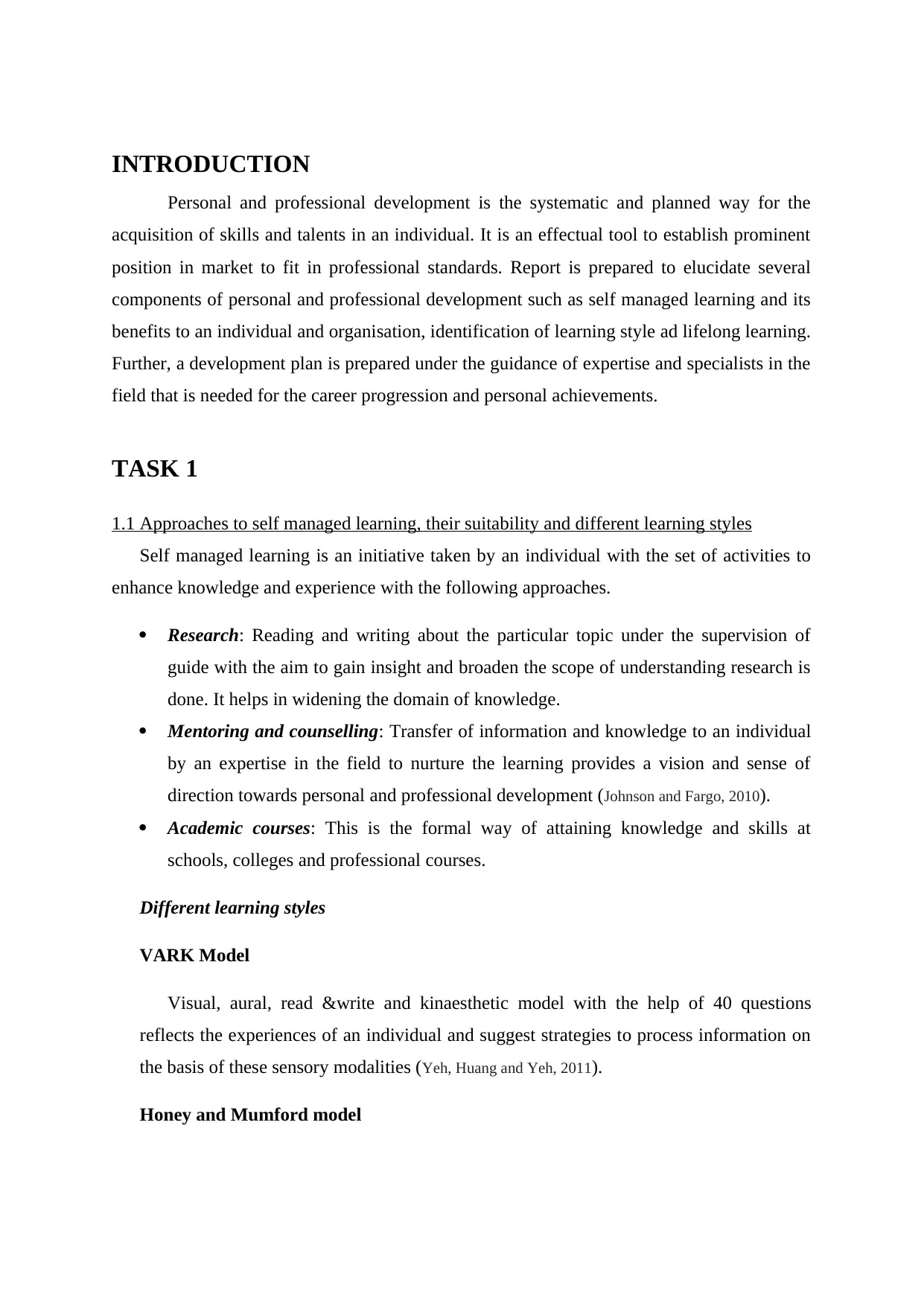
INTRODUCTION
Personal and professional development is the systematic and planned way for the
acquisition of skills and talents in an individual. It is an effectual tool to establish prominent
position in market to fit in professional standards. Report is prepared to elucidate several
components of personal and professional development such as self managed learning and its
benefits to an individual and organisation, identification of learning style ad lifelong learning.
Further, a development plan is prepared under the guidance of expertise and specialists in the
field that is needed for the career progression and personal achievements.
TASK 1
1.1 Approaches to self managed learning, their suitability and different learning styles
Self managed learning is an initiative taken by an individual with the set of activities to
enhance knowledge and experience with the following approaches.
Research: Reading and writing about the particular topic under the supervision of
guide with the aim to gain insight and broaden the scope of understanding research is
done. It helps in widening the domain of knowledge.
Mentoring and counselling: Transfer of information and knowledge to an individual
by an expertise in the field to nurture the learning provides a vision and sense of
direction towards personal and professional development (Johnson and Fargo, 2010).
Academic courses: This is the formal way of attaining knowledge and skills at
schools, colleges and professional courses.
Different learning styles
VARK Model
Visual, aural, read &write and kinaesthetic model with the help of 40 questions
reflects the experiences of an individual and suggest strategies to process information on
the basis of these sensory modalities (Yeh, Huang and Yeh, 2011).
Honey and Mumford model
Personal and professional development is the systematic and planned way for the
acquisition of skills and talents in an individual. It is an effectual tool to establish prominent
position in market to fit in professional standards. Report is prepared to elucidate several
components of personal and professional development such as self managed learning and its
benefits to an individual and organisation, identification of learning style ad lifelong learning.
Further, a development plan is prepared under the guidance of expertise and specialists in the
field that is needed for the career progression and personal achievements.
TASK 1
1.1 Approaches to self managed learning, their suitability and different learning styles
Self managed learning is an initiative taken by an individual with the set of activities to
enhance knowledge and experience with the following approaches.
Research: Reading and writing about the particular topic under the supervision of
guide with the aim to gain insight and broaden the scope of understanding research is
done. It helps in widening the domain of knowledge.
Mentoring and counselling: Transfer of information and knowledge to an individual
by an expertise in the field to nurture the learning provides a vision and sense of
direction towards personal and professional development (Johnson and Fargo, 2010).
Academic courses: This is the formal way of attaining knowledge and skills at
schools, colleges and professional courses.
Different learning styles
VARK Model
Visual, aural, read &write and kinaesthetic model with the help of 40 questions
reflects the experiences of an individual and suggest strategies to process information on
the basis of these sensory modalities (Yeh, Huang and Yeh, 2011).
Honey and Mumford model
⊘ This is a preview!⊘
Do you want full access?
Subscribe today to unlock all pages.

Trusted by 1+ million students worldwide
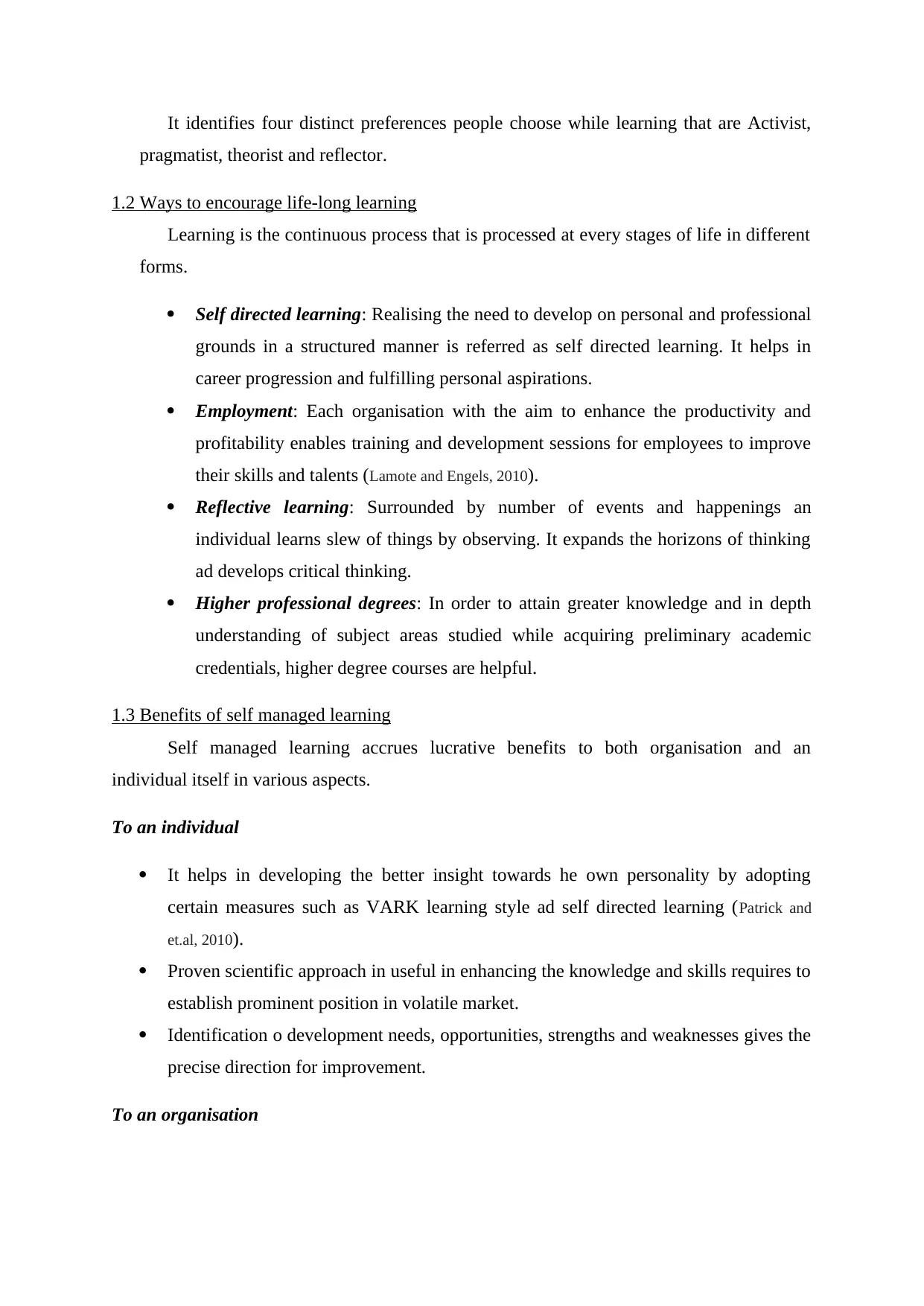
It identifies four distinct preferences people choose while learning that are Activist,
pragmatist, theorist and reflector.
1.2 Ways to encourage life-long learning
Learning is the continuous process that is processed at every stages of life in different
forms.
Self directed learning: Realising the need to develop on personal and professional
grounds in a structured manner is referred as self directed learning. It helps in
career progression and fulfilling personal aspirations.
Employment: Each organisation with the aim to enhance the productivity and
profitability enables training and development sessions for employees to improve
their skills and talents (Lamote and Engels, 2010).
Reflective learning: Surrounded by number of events and happenings an
individual learns slew of things by observing. It expands the horizons of thinking
ad develops critical thinking.
Higher professional degrees: In order to attain greater knowledge and in depth
understanding of subject areas studied while acquiring preliminary academic
credentials, higher degree courses are helpful.
1.3 Benefits of self managed learning
Self managed learning accrues lucrative benefits to both organisation and an
individual itself in various aspects.
To an individual
It helps in developing the better insight towards he own personality by adopting
certain measures such as VARK learning style ad self directed learning (Patrick and
et.al, 2010).
Proven scientific approach in useful in enhancing the knowledge and skills requires to
establish prominent position in volatile market.
Identification o development needs, opportunities, strengths and weaknesses gives the
precise direction for improvement.
To an organisation
pragmatist, theorist and reflector.
1.2 Ways to encourage life-long learning
Learning is the continuous process that is processed at every stages of life in different
forms.
Self directed learning: Realising the need to develop on personal and professional
grounds in a structured manner is referred as self directed learning. It helps in
career progression and fulfilling personal aspirations.
Employment: Each organisation with the aim to enhance the productivity and
profitability enables training and development sessions for employees to improve
their skills and talents (Lamote and Engels, 2010).
Reflective learning: Surrounded by number of events and happenings an
individual learns slew of things by observing. It expands the horizons of thinking
ad develops critical thinking.
Higher professional degrees: In order to attain greater knowledge and in depth
understanding of subject areas studied while acquiring preliminary academic
credentials, higher degree courses are helpful.
1.3 Benefits of self managed learning
Self managed learning accrues lucrative benefits to both organisation and an
individual itself in various aspects.
To an individual
It helps in developing the better insight towards he own personality by adopting
certain measures such as VARK learning style ad self directed learning (Patrick and
et.al, 2010).
Proven scientific approach in useful in enhancing the knowledge and skills requires to
establish prominent position in volatile market.
Identification o development needs, opportunities, strengths and weaknesses gives the
precise direction for improvement.
To an organisation
Paraphrase This Document
Need a fresh take? Get an instant paraphrase of this document with our AI Paraphraser
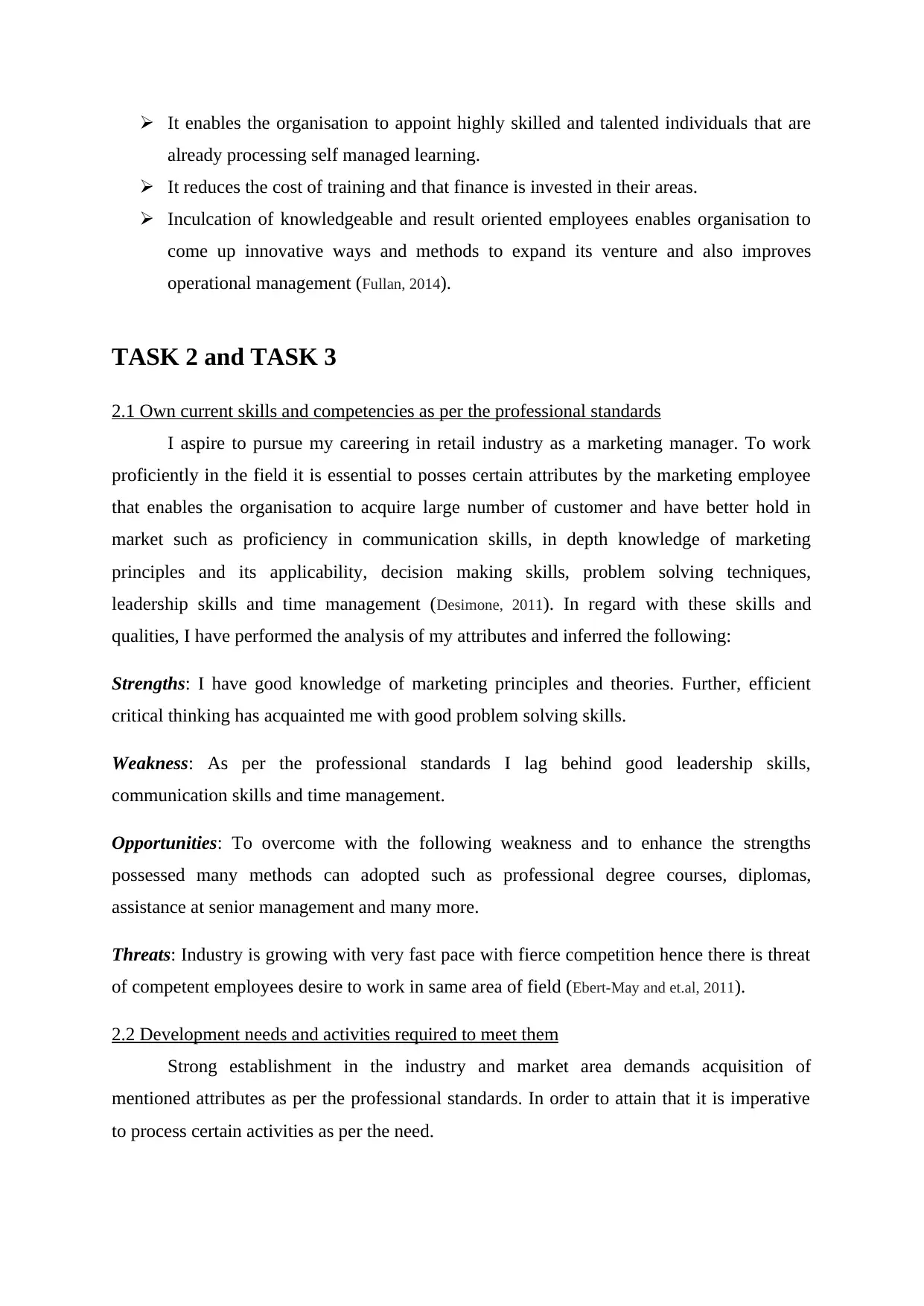
It enables the organisation to appoint highly skilled and talented individuals that are
already processing self managed learning.
It reduces the cost of training and that finance is invested in their areas.
Inculcation of knowledgeable and result oriented employees enables organisation to
come up innovative ways and methods to expand its venture and also improves
operational management (Fullan, 2014).
TASK 2 and TASK 3
2.1 Own current skills and competencies as per the professional standards
I aspire to pursue my careering in retail industry as a marketing manager. To work
proficiently in the field it is essential to posses certain attributes by the marketing employee
that enables the organisation to acquire large number of customer and have better hold in
market such as proficiency in communication skills, in depth knowledge of marketing
principles and its applicability, decision making skills, problem solving techniques,
leadership skills and time management (Desimone, 2011). In regard with these skills and
qualities, I have performed the analysis of my attributes and inferred the following:
Strengths: I have good knowledge of marketing principles and theories. Further, efficient
critical thinking has acquainted me with good problem solving skills.
Weakness: As per the professional standards I lag behind good leadership skills,
communication skills and time management.
Opportunities: To overcome with the following weakness and to enhance the strengths
possessed many methods can adopted such as professional degree courses, diplomas,
assistance at senior management and many more.
Threats: Industry is growing with very fast pace with fierce competition hence there is threat
of competent employees desire to work in same area of field (Ebert-May and et.al, 2011).
2.2 Development needs and activities required to meet them
Strong establishment in the industry and market area demands acquisition of
mentioned attributes as per the professional standards. In order to attain that it is imperative
to process certain activities as per the need.
already processing self managed learning.
It reduces the cost of training and that finance is invested in their areas.
Inculcation of knowledgeable and result oriented employees enables organisation to
come up innovative ways and methods to expand its venture and also improves
operational management (Fullan, 2014).
TASK 2 and TASK 3
2.1 Own current skills and competencies as per the professional standards
I aspire to pursue my careering in retail industry as a marketing manager. To work
proficiently in the field it is essential to posses certain attributes by the marketing employee
that enables the organisation to acquire large number of customer and have better hold in
market such as proficiency in communication skills, in depth knowledge of marketing
principles and its applicability, decision making skills, problem solving techniques,
leadership skills and time management (Desimone, 2011). In regard with these skills and
qualities, I have performed the analysis of my attributes and inferred the following:
Strengths: I have good knowledge of marketing principles and theories. Further, efficient
critical thinking has acquainted me with good problem solving skills.
Weakness: As per the professional standards I lag behind good leadership skills,
communication skills and time management.
Opportunities: To overcome with the following weakness and to enhance the strengths
possessed many methods can adopted such as professional degree courses, diplomas,
assistance at senior management and many more.
Threats: Industry is growing with very fast pace with fierce competition hence there is threat
of competent employees desire to work in same area of field (Ebert-May and et.al, 2011).
2.2 Development needs and activities required to meet them
Strong establishment in the industry and market area demands acquisition of
mentioned attributes as per the professional standards. In order to attain that it is imperative
to process certain activities as per the need.
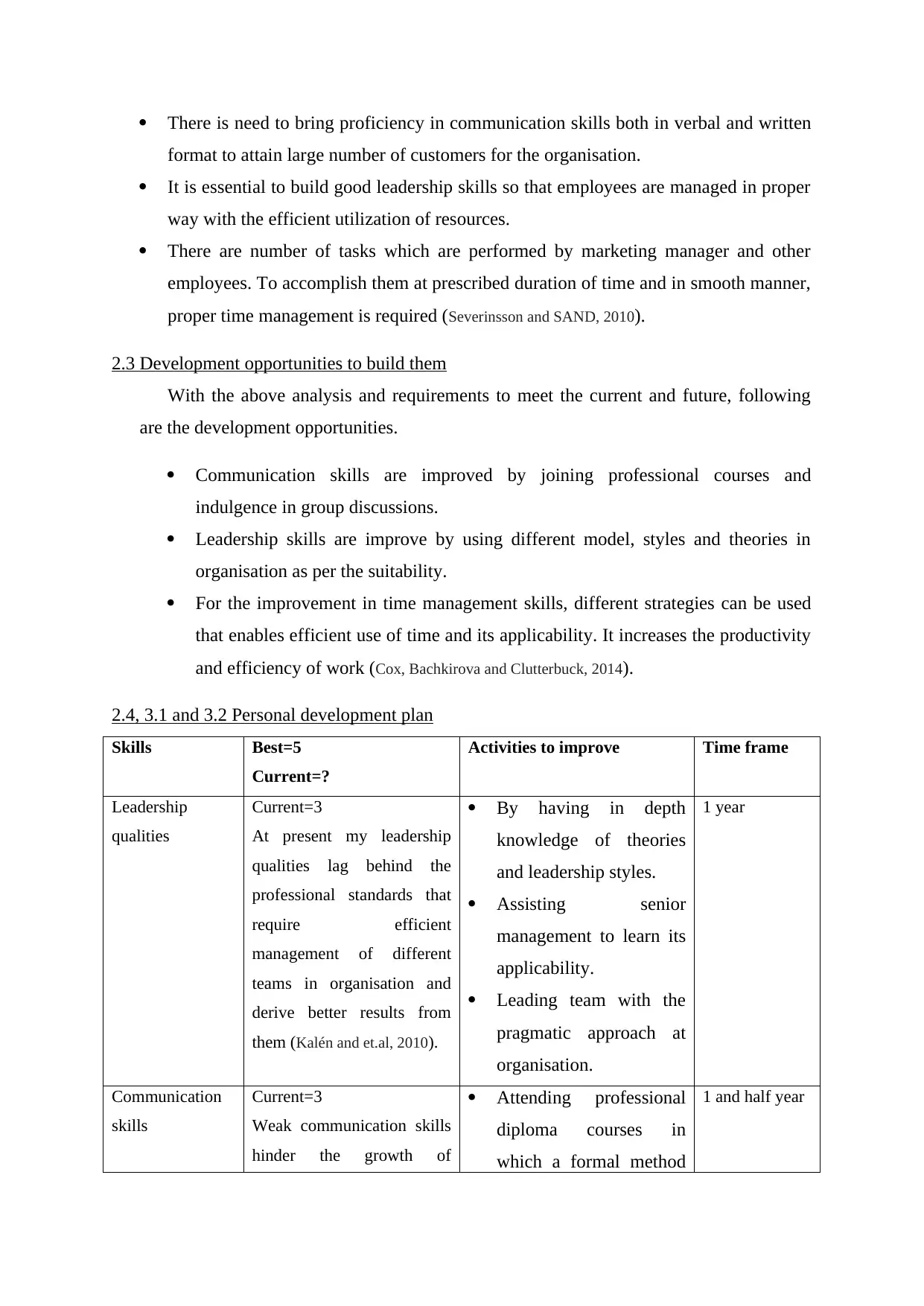
There is need to bring proficiency in communication skills both in verbal and written
format to attain large number of customers for the organisation.
It is essential to build good leadership skills so that employees are managed in proper
way with the efficient utilization of resources.
There are number of tasks which are performed by marketing manager and other
employees. To accomplish them at prescribed duration of time and in smooth manner,
proper time management is required (Severinsson and SAND, 2010).
2.3 Development opportunities to build them
With the above analysis and requirements to meet the current and future, following
are the development opportunities.
Communication skills are improved by joining professional courses and
indulgence in group discussions.
Leadership skills are improve by using different model, styles and theories in
organisation as per the suitability.
For the improvement in time management skills, different strategies can be used
that enables efficient use of time and its applicability. It increases the productivity
and efficiency of work (Cox, Bachkirova and Clutterbuck, 2014).
2.4, 3.1 and 3.2 Personal development plan
Skills Best=5
Current=?
Activities to improve Time frame
Leadership
qualities
Current=3
At present my leadership
qualities lag behind the
professional standards that
require efficient
management of different
teams in organisation and
derive better results from
them (Kalén and et.al, 2010).
By having in depth
knowledge of theories
and leadership styles.
Assisting senior
management to learn its
applicability.
Leading team with the
pragmatic approach at
organisation.
1 year
Communication
skills
Current=3
Weak communication skills
hinder the growth of
Attending professional
diploma courses in
which a formal method
1 and half year
format to attain large number of customers for the organisation.
It is essential to build good leadership skills so that employees are managed in proper
way with the efficient utilization of resources.
There are number of tasks which are performed by marketing manager and other
employees. To accomplish them at prescribed duration of time and in smooth manner,
proper time management is required (Severinsson and SAND, 2010).
2.3 Development opportunities to build them
With the above analysis and requirements to meet the current and future, following
are the development opportunities.
Communication skills are improved by joining professional courses and
indulgence in group discussions.
Leadership skills are improve by using different model, styles and theories in
organisation as per the suitability.
For the improvement in time management skills, different strategies can be used
that enables efficient use of time and its applicability. It increases the productivity
and efficiency of work (Cox, Bachkirova and Clutterbuck, 2014).
2.4, 3.1 and 3.2 Personal development plan
Skills Best=5
Current=?
Activities to improve Time frame
Leadership
qualities
Current=3
At present my leadership
qualities lag behind the
professional standards that
require efficient
management of different
teams in organisation and
derive better results from
them (Kalén and et.al, 2010).
By having in depth
knowledge of theories
and leadership styles.
Assisting senior
management to learn its
applicability.
Leading team with the
pragmatic approach at
organisation.
1 year
Communication
skills
Current=3
Weak communication skills
hinder the growth of
Attending professional
diploma courses in
which a formal method
1 and half year
⊘ This is a preview!⊘
Do you want full access?
Subscribe today to unlock all pages.

Trusted by 1+ million students worldwide
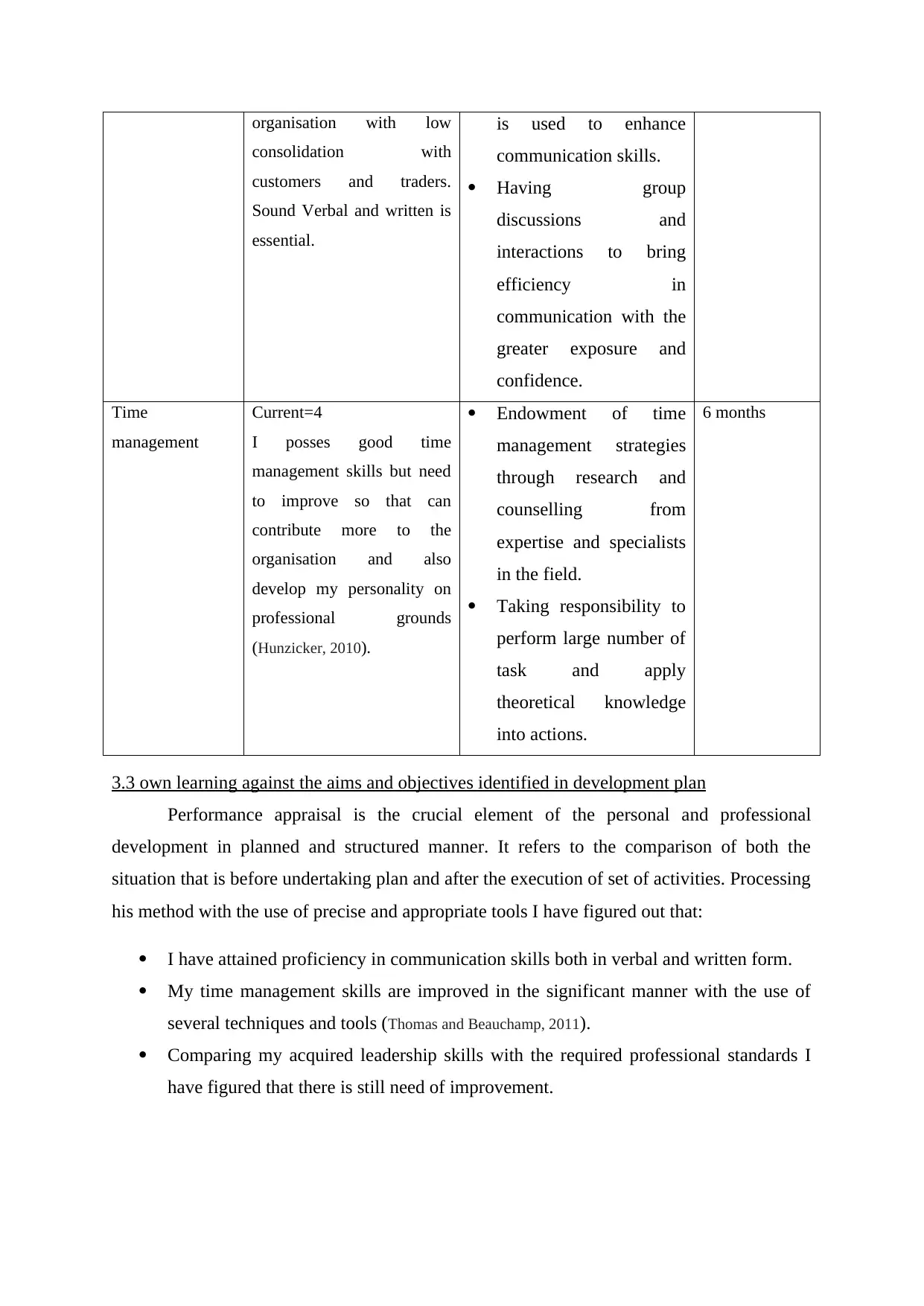
organisation with low
consolidation with
customers and traders.
Sound Verbal and written is
essential.
is used to enhance
communication skills.
Having group
discussions and
interactions to bring
efficiency in
communication with the
greater exposure and
confidence.
Time
management
Current=4
I posses good time
management skills but need
to improve so that can
contribute more to the
organisation and also
develop my personality on
professional grounds
(Hunzicker, 2010).
Endowment of time
management strategies
through research and
counselling from
expertise and specialists
in the field.
Taking responsibility to
perform large number of
task and apply
theoretical knowledge
into actions.
6 months
3.3 own learning against the aims and objectives identified in development plan
Performance appraisal is the crucial element of the personal and professional
development in planned and structured manner. It refers to the comparison of both the
situation that is before undertaking plan and after the execution of set of activities. Processing
his method with the use of precise and appropriate tools I have figured out that:
I have attained proficiency in communication skills both in verbal and written form.
My time management skills are improved in the significant manner with the use of
several techniques and tools (Thomas and Beauchamp, 2011).
Comparing my acquired leadership skills with the required professional standards I
have figured that there is still need of improvement.
consolidation with
customers and traders.
Sound Verbal and written is
essential.
is used to enhance
communication skills.
Having group
discussions and
interactions to bring
efficiency in
communication with the
greater exposure and
confidence.
Time
management
Current=4
I posses good time
management skills but need
to improve so that can
contribute more to the
organisation and also
develop my personality on
professional grounds
(Hunzicker, 2010).
Endowment of time
management strategies
through research and
counselling from
expertise and specialists
in the field.
Taking responsibility to
perform large number of
task and apply
theoretical knowledge
into actions.
6 months
3.3 own learning against the aims and objectives identified in development plan
Performance appraisal is the crucial element of the personal and professional
development in planned and structured manner. It refers to the comparison of both the
situation that is before undertaking plan and after the execution of set of activities. Processing
his method with the use of precise and appropriate tools I have figured out that:
I have attained proficiency in communication skills both in verbal and written form.
My time management skills are improved in the significant manner with the use of
several techniques and tools (Thomas and Beauchamp, 2011).
Comparing my acquired leadership skills with the required professional standards I
have figured that there is still need of improvement.
Paraphrase This Document
Need a fresh take? Get an instant paraphrase of this document with our AI Paraphraser
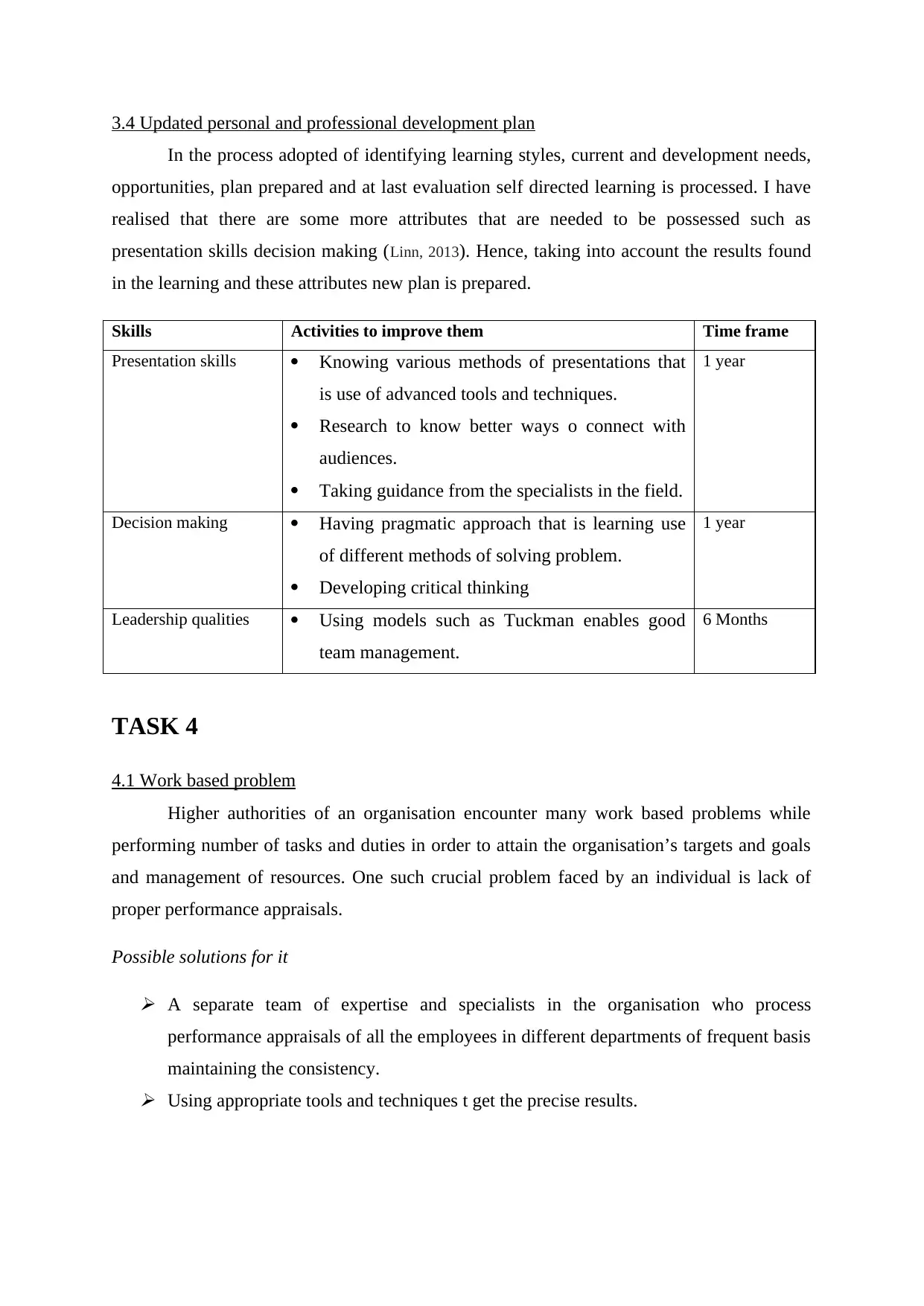
3.4 Updated personal and professional development plan
In the process adopted of identifying learning styles, current and development needs,
opportunities, plan prepared and at last evaluation self directed learning is processed. I have
realised that there are some more attributes that are needed to be possessed such as
presentation skills decision making (Linn, 2013). Hence, taking into account the results found
in the learning and these attributes new plan is prepared.
Skills Activities to improve them Time frame
Presentation skills Knowing various methods of presentations that
is use of advanced tools and techniques.
Research to know better ways o connect with
audiences.
Taking guidance from the specialists in the field.
1 year
Decision making Having pragmatic approach that is learning use
of different methods of solving problem.
Developing critical thinking
1 year
Leadership qualities Using models such as Tuckman enables good
team management.
6 Months
TASK 4
4.1 Work based problem
Higher authorities of an organisation encounter many work based problems while
performing number of tasks and duties in order to attain the organisation’s targets and goals
and management of resources. One such crucial problem faced by an individual is lack of
proper performance appraisals.
Possible solutions for it
A separate team of expertise and specialists in the organisation who process
performance appraisals of all the employees in different departments of frequent basis
maintaining the consistency. Using appropriate tools and techniques t get the precise results.
In the process adopted of identifying learning styles, current and development needs,
opportunities, plan prepared and at last evaluation self directed learning is processed. I have
realised that there are some more attributes that are needed to be possessed such as
presentation skills decision making (Linn, 2013). Hence, taking into account the results found
in the learning and these attributes new plan is prepared.
Skills Activities to improve them Time frame
Presentation skills Knowing various methods of presentations that
is use of advanced tools and techniques.
Research to know better ways o connect with
audiences.
Taking guidance from the specialists in the field.
1 year
Decision making Having pragmatic approach that is learning use
of different methods of solving problem.
Developing critical thinking
1 year
Leadership qualities Using models such as Tuckman enables good
team management.
6 Months
TASK 4
4.1 Work based problem
Higher authorities of an organisation encounter many work based problems while
performing number of tasks and duties in order to attain the organisation’s targets and goals
and management of resources. One such crucial problem faced by an individual is lack of
proper performance appraisals.
Possible solutions for it
A separate team of expertise and specialists in the organisation who process
performance appraisals of all the employees in different departments of frequent basis
maintaining the consistency. Using appropriate tools and techniques t get the precise results.
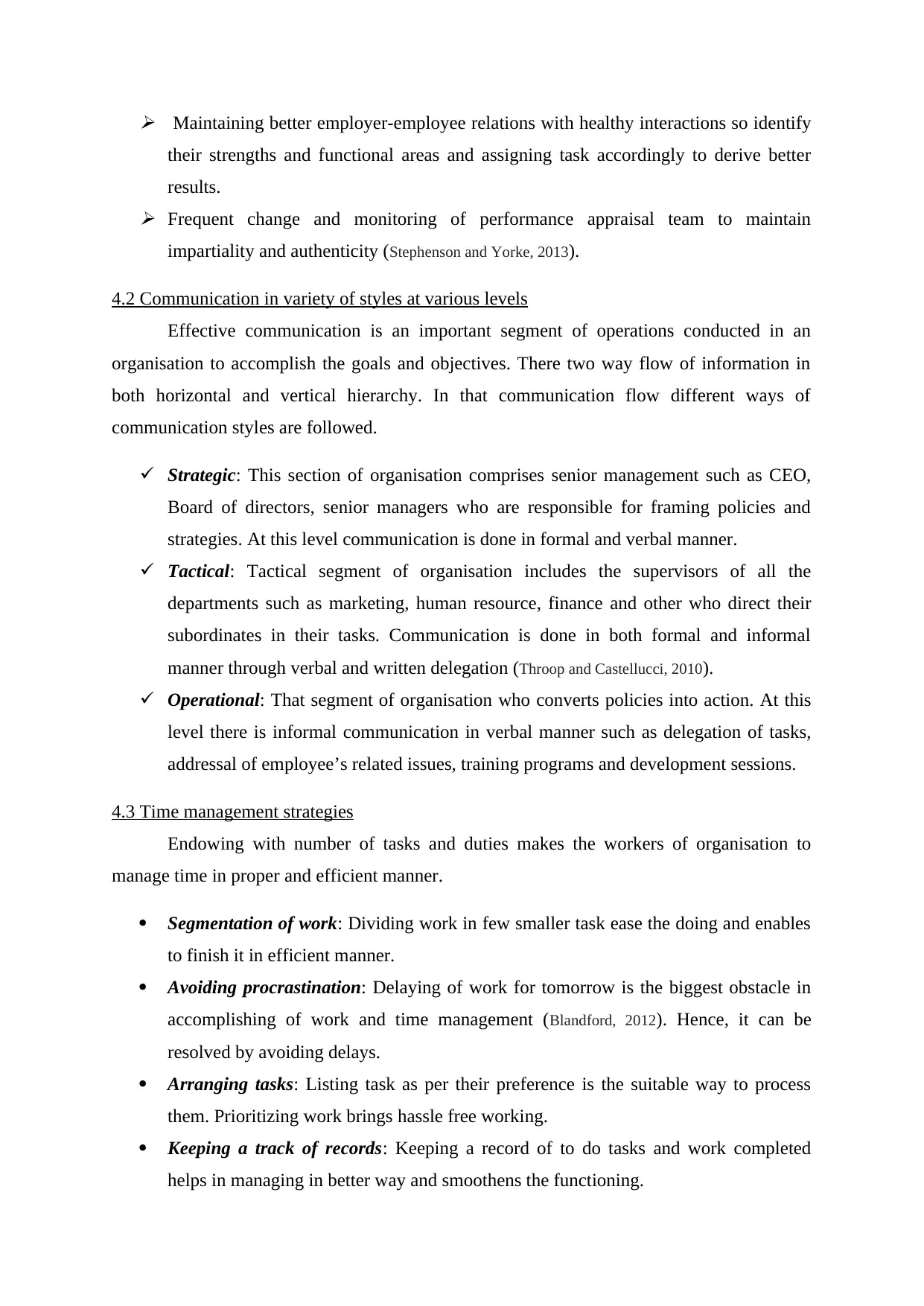
Maintaining better employer-employee relations with healthy interactions so identify
their strengths and functional areas and assigning task accordingly to derive better
results. Frequent change and monitoring of performance appraisal team to maintain
impartiality and authenticity (Stephenson and Yorke, 2013).
4.2 Communication in variety of styles at various levels
Effective communication is an important segment of operations conducted in an
organisation to accomplish the goals and objectives. There two way flow of information in
both horizontal and vertical hierarchy. In that communication flow different ways of
communication styles are followed.
Strategic: This section of organisation comprises senior management such as CEO,
Board of directors, senior managers who are responsible for framing policies and
strategies. At this level communication is done in formal and verbal manner.
Tactical: Tactical segment of organisation includes the supervisors of all the
departments such as marketing, human resource, finance and other who direct their
subordinates in their tasks. Communication is done in both formal and informal
manner through verbal and written delegation (Throop and Castellucci, 2010).
Operational: That segment of organisation who converts policies into action. At this
level there is informal communication in verbal manner such as delegation of tasks,
addressal of employee’s related issues, training programs and development sessions.
4.3 Time management strategies
Endowing with number of tasks and duties makes the workers of organisation to
manage time in proper and efficient manner.
Segmentation of work: Dividing work in few smaller task ease the doing and enables
to finish it in efficient manner.
Avoiding procrastination: Delaying of work for tomorrow is the biggest obstacle in
accomplishing of work and time management (Blandford, 2012). Hence, it can be
resolved by avoiding delays.
Arranging tasks: Listing task as per their preference is the suitable way to process
them. Prioritizing work brings hassle free working.
Keeping a track of records: Keeping a record of to do tasks and work completed
helps in managing in better way and smoothens the functioning.
their strengths and functional areas and assigning task accordingly to derive better
results. Frequent change and monitoring of performance appraisal team to maintain
impartiality and authenticity (Stephenson and Yorke, 2013).
4.2 Communication in variety of styles at various levels
Effective communication is an important segment of operations conducted in an
organisation to accomplish the goals and objectives. There two way flow of information in
both horizontal and vertical hierarchy. In that communication flow different ways of
communication styles are followed.
Strategic: This section of organisation comprises senior management such as CEO,
Board of directors, senior managers who are responsible for framing policies and
strategies. At this level communication is done in formal and verbal manner.
Tactical: Tactical segment of organisation includes the supervisors of all the
departments such as marketing, human resource, finance and other who direct their
subordinates in their tasks. Communication is done in both formal and informal
manner through verbal and written delegation (Throop and Castellucci, 2010).
Operational: That segment of organisation who converts policies into action. At this
level there is informal communication in verbal manner such as delegation of tasks,
addressal of employee’s related issues, training programs and development sessions.
4.3 Time management strategies
Endowing with number of tasks and duties makes the workers of organisation to
manage time in proper and efficient manner.
Segmentation of work: Dividing work in few smaller task ease the doing and enables
to finish it in efficient manner.
Avoiding procrastination: Delaying of work for tomorrow is the biggest obstacle in
accomplishing of work and time management (Blandford, 2012). Hence, it can be
resolved by avoiding delays.
Arranging tasks: Listing task as per their preference is the suitable way to process
them. Prioritizing work brings hassle free working.
Keeping a track of records: Keeping a record of to do tasks and work completed
helps in managing in better way and smoothens the functioning.
⊘ This is a preview!⊘
Do you want full access?
Subscribe today to unlock all pages.

Trusted by 1+ million students worldwide
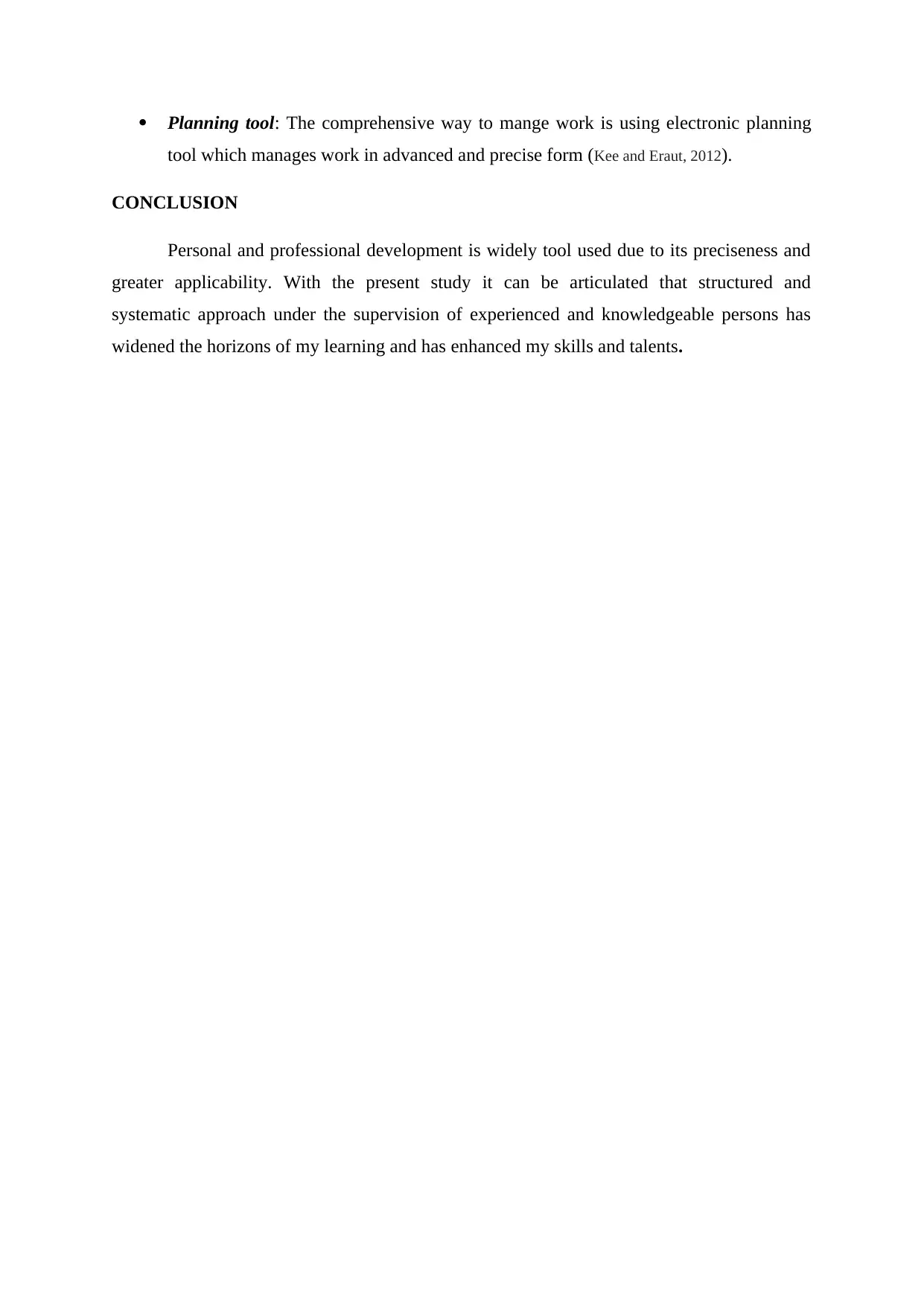
Planning tool: The comprehensive way to mange work is using electronic planning
tool which manages work in advanced and precise form (Kee and Eraut, 2012).
CONCLUSION
Personal and professional development is widely tool used due to its preciseness and
greater applicability. With the present study it can be articulated that structured and
systematic approach under the supervision of experienced and knowledgeable persons has
widened the horizons of my learning and has enhanced my skills and talents.
tool which manages work in advanced and precise form (Kee and Eraut, 2012).
CONCLUSION
Personal and professional development is widely tool used due to its preciseness and
greater applicability. With the present study it can be articulated that structured and
systematic approach under the supervision of experienced and knowledgeable persons has
widened the horizons of my learning and has enhanced my skills and talents.
Paraphrase This Document
Need a fresh take? Get an instant paraphrase of this document with our AI Paraphraser
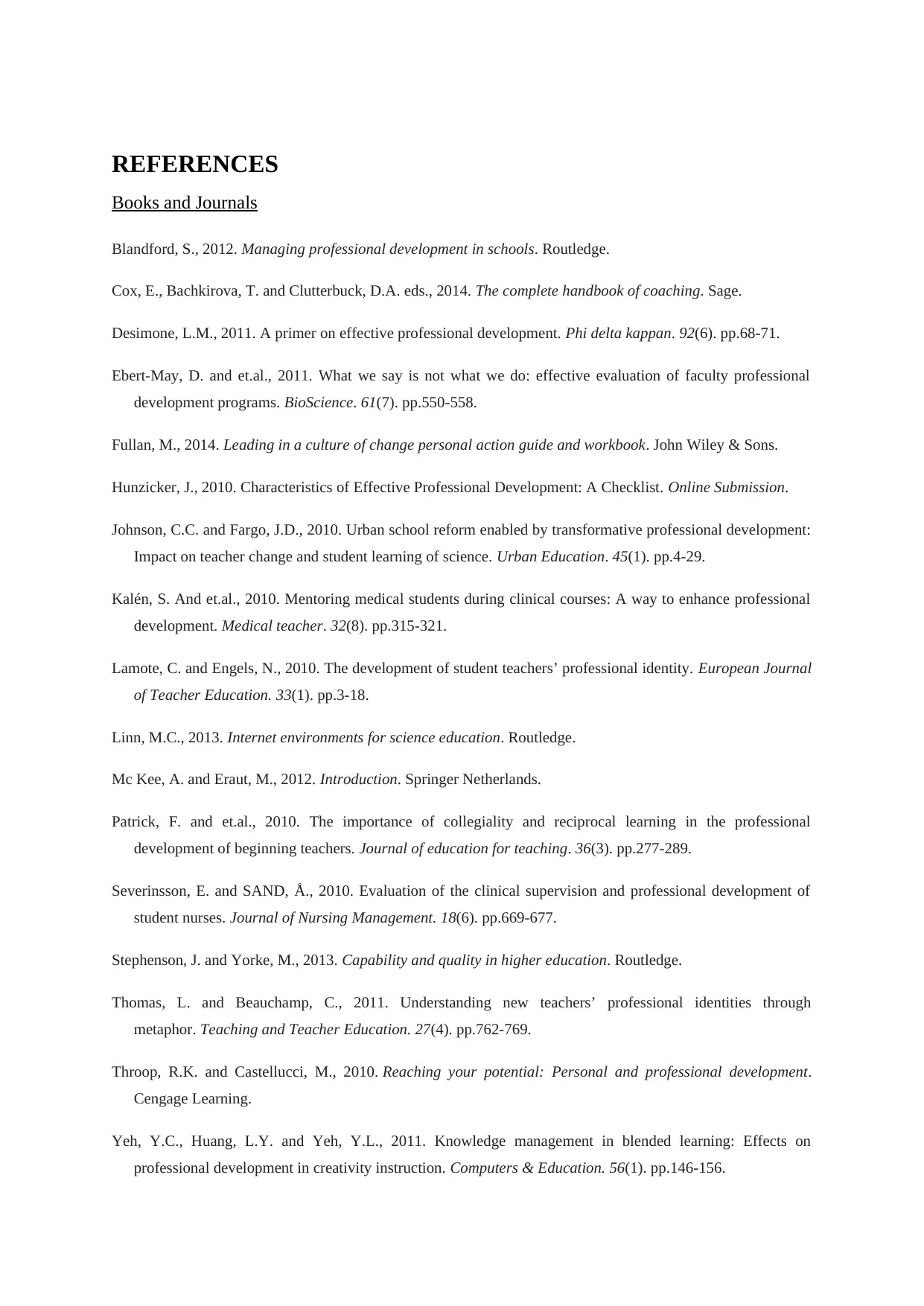
REFERENCES
Books and Journals
Blandford, S., 2012. Managing professional development in schools. Routledge.
Cox, E., Bachkirova, T. and Clutterbuck, D.A. eds., 2014. The complete handbook of coaching. Sage.
Desimone, L.M., 2011. A primer on effective professional development. Phi delta kappan. 92(6). pp.68-71.
Ebert-May, D. and et.al., 2011. What we say is not what we do: effective evaluation of faculty professional
development programs. BioScience. 61(7). pp.550-558.
Fullan, M., 2014. Leading in a culture of change personal action guide and workbook. John Wiley & Sons.
Hunzicker, J., 2010. Characteristics of Effective Professional Development: A Checklist. Online Submission.
Johnson, C.C. and Fargo, J.D., 2010. Urban school reform enabled by transformative professional development:
Impact on teacher change and student learning of science. Urban Education. 45(1). pp.4-29.
Kalén, S. And et.al., 2010. Mentoring medical students during clinical courses: A way to enhance professional
development. Medical teacher. 32(8). pp.315-321.
Lamote, C. and Engels, N., 2010. The development of student teachers’ professional identity. European Journal
of Teacher Education. 33(1). pp.3-18.
Linn, M.C., 2013. Internet environments for science education. Routledge.
Mc Kee, A. and Eraut, M., 2012. Introduction. Springer Netherlands.
Patrick, F. and et.al., 2010. The importance of collegiality and reciprocal learning in the professional
development of beginning teachers. Journal of education for teaching. 36(3). pp.277-289.
Severinsson, E. and SAND, Å., 2010. Evaluation of the clinical supervision and professional development of
student nurses. Journal of Nursing Management. 18(6). pp.669-677.
Stephenson, J. and Yorke, M., 2013. Capability and quality in higher education. Routledge.
Thomas, L. and Beauchamp, C., 2011. Understanding new teachers’ professional identities through
metaphor. Teaching and Teacher Education. 27(4). pp.762-769.
Throop, R.K. and Castellucci, M., 2010. Reaching your potential: Personal and professional development.
Cengage Learning.
Yeh, Y.C., Huang, L.Y. and Yeh, Y.L., 2011. Knowledge management in blended learning: Effects on
professional development in creativity instruction. Computers & Education. 56(1). pp.146-156.
Books and Journals
Blandford, S., 2012. Managing professional development in schools. Routledge.
Cox, E., Bachkirova, T. and Clutterbuck, D.A. eds., 2014. The complete handbook of coaching. Sage.
Desimone, L.M., 2011. A primer on effective professional development. Phi delta kappan. 92(6). pp.68-71.
Ebert-May, D. and et.al., 2011. What we say is not what we do: effective evaluation of faculty professional
development programs. BioScience. 61(7). pp.550-558.
Fullan, M., 2014. Leading in a culture of change personal action guide and workbook. John Wiley & Sons.
Hunzicker, J., 2010. Characteristics of Effective Professional Development: A Checklist. Online Submission.
Johnson, C.C. and Fargo, J.D., 2010. Urban school reform enabled by transformative professional development:
Impact on teacher change and student learning of science. Urban Education. 45(1). pp.4-29.
Kalén, S. And et.al., 2010. Mentoring medical students during clinical courses: A way to enhance professional
development. Medical teacher. 32(8). pp.315-321.
Lamote, C. and Engels, N., 2010. The development of student teachers’ professional identity. European Journal
of Teacher Education. 33(1). pp.3-18.
Linn, M.C., 2013. Internet environments for science education. Routledge.
Mc Kee, A. and Eraut, M., 2012. Introduction. Springer Netherlands.
Patrick, F. and et.al., 2010. The importance of collegiality and reciprocal learning in the professional
development of beginning teachers. Journal of education for teaching. 36(3). pp.277-289.
Severinsson, E. and SAND, Å., 2010. Evaluation of the clinical supervision and professional development of
student nurses. Journal of Nursing Management. 18(6). pp.669-677.
Stephenson, J. and Yorke, M., 2013. Capability and quality in higher education. Routledge.
Thomas, L. and Beauchamp, C., 2011. Understanding new teachers’ professional identities through
metaphor. Teaching and Teacher Education. 27(4). pp.762-769.
Throop, R.K. and Castellucci, M., 2010. Reaching your potential: Personal and professional development.
Cengage Learning.
Yeh, Y.C., Huang, L.Y. and Yeh, Y.L., 2011. Knowledge management in blended learning: Effects on
professional development in creativity instruction. Computers & Education. 56(1). pp.146-156.
1 out of 11
Related Documents
Your All-in-One AI-Powered Toolkit for Academic Success.
+13062052269
info@desklib.com
Available 24*7 on WhatsApp / Email
![[object Object]](/_next/static/media/star-bottom.7253800d.svg)
Unlock your academic potential
Copyright © 2020–2025 A2Z Services. All Rights Reserved. Developed and managed by ZUCOL.




